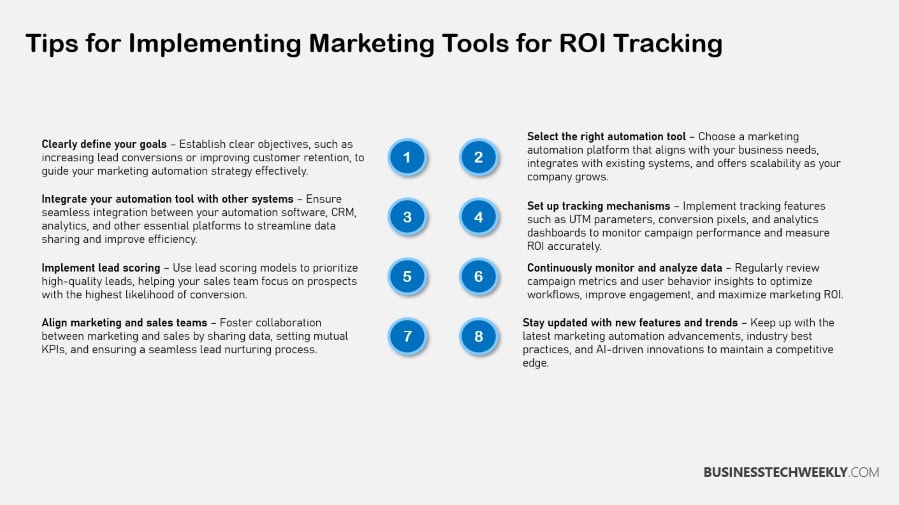ROI of Marketing Automation: What you need to know

On this page:
What is Marketing Automation
Definition of Marketing Automation
Marketing automation is an approach to marketing that’s based on software that allows you to automate repetitive marketing tasks.
This methodology increases efficiency by letting automation technology take care of repetitive processes.
With automation tools, you won’t have to send emails out manually or segment customer lists yourself.
This gives marketing teams the bandwidth to prioritize strategic initiatives.
Automation plays a critical role in ensuring messaging remains consistent between campaigns. This cohesion is what creates a powerful brand identity.
Once businesses start to scale, the need to be able to provide a consistent experience to all leads and customers is key.
This consistency ensures that each interaction is given the same time and care, and the same creativity and interest.
As a result, it creates a formidable ROI that frequently exceeds 500%.
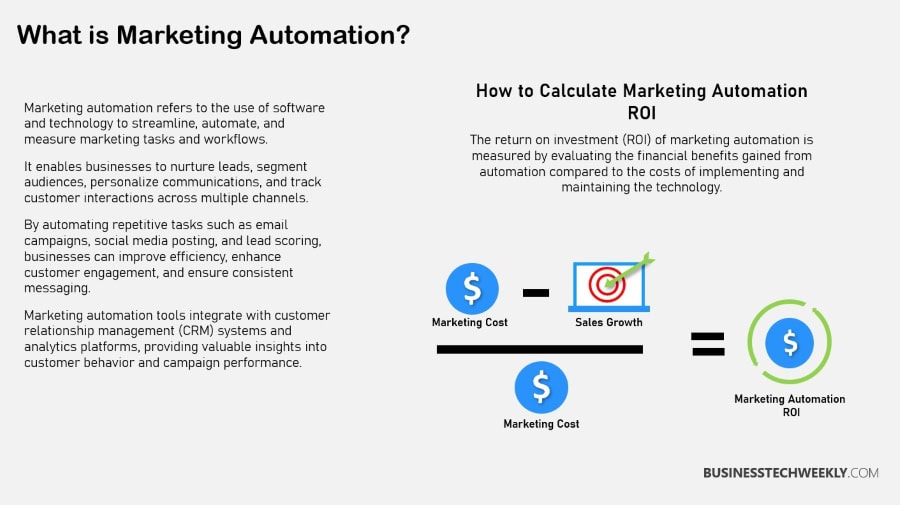
Key Components of Marketing Automation
Email marketing, lead scoring, and analytics tools are the core of any centralized system.
Platforms that connect with CRM systems further improve these efforts by providing a 360-degree view of customer interactions.
As 87% of organizations have implemented such solutions, data management capabilities are especially important when it comes to targeting highly personalized messages to narrow audience segments.
Not only does automation free up more time spent on manual tasks such as lead scoring and qualification, it accelerates lead generation initiatives.
In return, companies are able to pursue better quality leads, earning back the cost of investment in under six months.
When you can personalize customer experiences through tailored messaging, it adds another layer of engagement that makes the investment and effort more valuable.
RELATED: How to Set Up an Effective Marketing Automation System
Measuring the ROI of Marketing Automation
Measuring the ROI of marketing automation is essential to determine how well your marketing tactics are performing.
Companies are missing out on a great deal by not taking a more systematic approach to determine the economic payoffs from automation.
This methodology allows for a better understanding of what’s working in marketing investments and supports continued spend.
Defining your metrics carefully starts you on the right track to calculating your ROI accurately, and that’s crucial for matching them up to your overall business objectives.
1. Define the ROI of Marketing Automation Metrics
- Sales growth
- Cost savings
- Customer acquisition costs
Align these metrics with your overall business objectives to drive insights and action.
By relying on percentage-based metrics, you gain a holistic picture of the specific effect that automation has had on your revenue.
On average, companies have seen an impressive return of $5.44 for each dollar invested in marketing automation.
Even better, this exceptional result often happens within the first three years.
2. Track Conversion Rates
Conversion rates are essential in measuring the success of your marketing automation.
Leverage analytics tools to keep a pulse on user behavior and identify winning strategies.
Use them as benchmarks to measure progress. Companies that have adopted automation report an 80% increase in leads.
3. Analyze Customer Engagement
Measure how engaged your customers and prospects are through multiple measurable statistics such as email open rates or click-through rates.
This information allows for constant fine-tuning of tactics and more personalized engagement.
Regularly monitor:
- Email open rates
- Click-through rates
4. Evaluate Cost Savings
Identify and compare the process manually versus automated to determine time savings and cost savings.
In this case, automation saves costs in staffing and other resources, making investments more justifiable.
On average, companies recoup their upfront investment in less than half a year.
5. Assess Revenue Growth
Increased revenue growth is the most obvious benefit of effective automation.
Compare sales data before and after you’ve implemented Mautic to understand the financial impacts.
Link your revenue growth back to specific campaigns so you can identify what you are doing right.
Businesses that have adopted automation are seeing revenues increase by an average of 34%.
Benefits of Marketing Automation
Increased Efficiency
Efficiency Marketing automation increases efficiency through automation of repetitive tasks, such as social media posts and email marketing campaigns.
This time and effort savings means your team can spend more time on work that is strategic rather than tactical.
Automation tools enable campaigns to move faster, allowing you to pivot with the market, increasing team productivity and morale.
In return, marketing automation will deliver measurable revenue growth, typically 10% to 20% greater than the cost of the technology itself.
Enhanced Customer Experience
Automation takes marketing personalization to another level, creating better customer journeys through targeted, relevant messaging.
This relevant and timely interaction increases satisfaction and loyalty, fostering deep relationships.
Feedback loops constantly refine your strategies, making sure your communication is always as on-point and interesting as possible.
Marketing orchestration Advanced marketing platforms are leveraging AI to create highly original content, personalized recommendations, and interactions that deeply resonate, and are proven to drive better results.
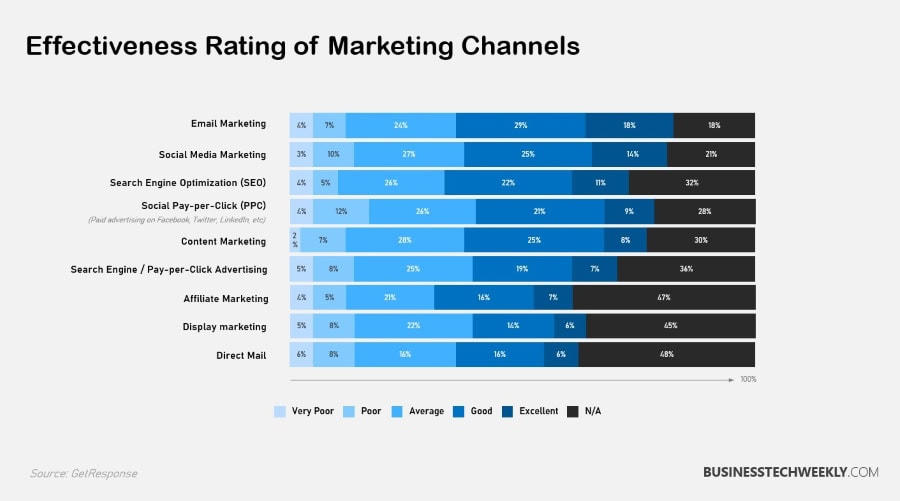
Improved Lead Management
By ensuring only relevant prospects see your message and stay engaged, you’ll often see improved conversion rates and an increased customer lifetime value.
Lead scoring systems automatically prioritize only the highest-quality leads, so your sales teams can spend their time on the most promising opportunities.
By integrating automation with CRM systems, organizations can ensure a seamless flow of leads through the funnel, reducing customer acquisition costs and maximizing ROI.
RELATED: Delivering Results with Marketing Automation
Better Data Insights
Detailed analytics give you a clear picture of customer habits and preferences.
With data-driven strategies, marketers can make precise adjustments to ensure their campaigns are as effective as possible.
Important data points to examine are engagement rates, lead quality, conversion metrics, and customer feedback.
This allows everyone involved to be more strategic and make data-driven decisions that drive stronger business results.
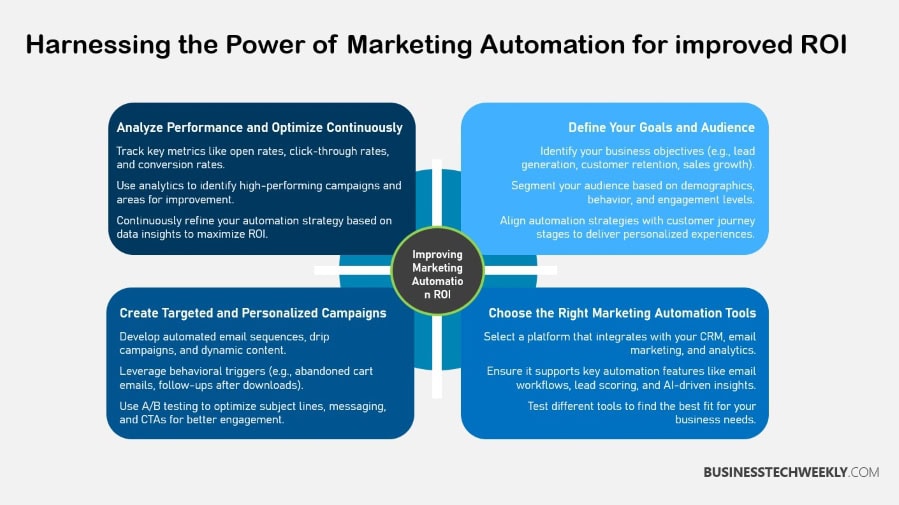
Challenges of Marketing Automation
While marketing automation can increase efficiency, there are challenges.
Businesses really struggle when they try to plug new automation tools into their existing architectures.
This can create lack of compatibility, which can paralyze integrated operations.
Making sure all your software platforms can work in conjunction is key.
To address the integration challenges, you may want to engage IT teams to help chart existing systems and identify missing needs.
Providing middleware or APIs to address any connectivity gaps can go a long way to improve marketing efficiency and effectiveness.
Integration Issues
Marketing automation tools don’t work in a vacuum. Systems don’t always integrate, creating data silos or breaking the desired workflow.
Ease of use compatibility is probably the most obvious challenge of marketing automation but all the same, it’s worth mentioning.
To ease the burden of integration, start with a deep audit of your current tools.
Either find an MA that works with your current platforms or be willing to invest in middleware solutions that will help disparate systems communicate.
This method can increase the effectiveness of your broader marketing strategy, as it puts all your tools and tactics in sync.
Data Privacy Concerns
Data privacy is a hot topic in the world of marketing automation. Staying on the right side of regulations such as GDPR and CCPA is critical to prevent legal trouble.
Being up front about how you use and protect customer data is important to building and keeping customer trust.
By implementing clear data policies and regularly reviewing them, you can protect yourself and remain compliant. Educate your team on the importance of data privacy.
This will get everyone on the same page with best practices and contribute to the development of a trustworthy brand persona.
Complexity of Implementation
It’s true, setting up marketing automation systems can feel overwhelming.
Doing so does take a strong strategy to steer through the intricacies that come into play.
An implementation plan serves as your implementation roadmap, walking you through every step and keeping you on track to avoid pitfalls and missteps.
Ongoing support and training are critical in making sure your team doesn’t lose their edge.
Plan to invest in ongoing training, which will help you adopt and use the tools to their full potential.
Cost Considerations
There are definitely costs associated with marketing automation tools—software subscriptions, set up fees associated with implementing the software, etc.
Analyzing these costs compared to potential returns is essential for justifying the investment.
Although up-front costs can be significant, the return on investment (ROI) from more efficient processes and improved customer interaction usually offset that cost.
Touching base regularly and mapping out clear expectations are both keys to success between you and your chosen platform.
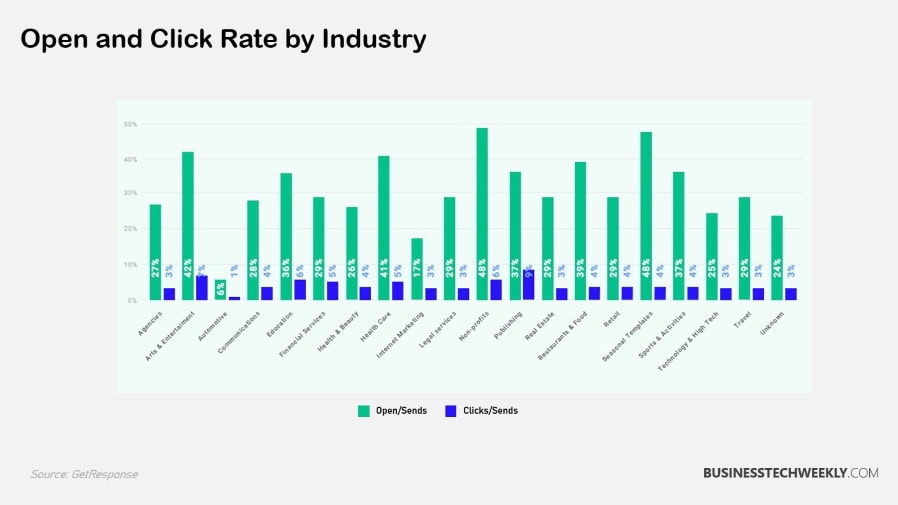
Best Practices for Maximizing the ROI of Marketing Automation
Align with Business Goals
When you align your marketing automation strategies with your business goals, you run more effective and powerful marketing efforts.
When automation projects align with larger goals, they bring together marketing and sales, increasing alignment and efficiency.
Having specific, measurable goals gives you and your team clear focus and guidance.
For instance, increase the quality of leads generated by 20% or improve customer interaction by 30%.
When coupled with proper integration to other systems such as CRM, the information flows seamlessly, compounding the benefits and improving ROI.
Regularly Monitor Performance
Always be monitoring. Regularly checking up on your marketing automation is the crux of success.
Setting up a process for regularly reviewing KPIs keeps you informed of how things are going.
With the right analytics tools, marketers can make data-driven use adjustments, keeping campaigns optimized and focused on reaching core goals.
Using data collected from all platforms provides a more comprehensive picture, helping inform the best course of action strategically.
Organizations should target a 50% improvement in lead generation effectiveness and a 30% decrease in manual labor.
RELATED: eCommerce Automation: Streamline and Automate your Online Business
Invest in Training and Support
Investing in extensive training for your marketing team is key to maximizing the impact of automation tools.
Continued assistance from software providers helps meet challenges and get the most out of the tools.
A culture of learning allows your teams to better adjust to emerging technology.
With specialized teams in place, companies experience more qualified leads and reduced customer acquisition costs.
Each $1 you invested would result in $0.10-$0.20 of profit, a great return on investment.
Key Points to Note
Marketing automation helps you supercharge your marketing efforts by giving you more time and resources.
Measuring ROI is significantly easier, giving you concrete information about what works and what doesn’t in your strategy.
- Marketing automation uses software to automate and simplify repetitive marketing tasks, making teams more efficient and freeing up time to focus on higher-level strategies.
- Measuring the ROI of marketing automation is essential to determine financial returns and overall success of marketing investments.
- Examples of key ROI metrics of marketing automation would be sales growth, savings, cost per acquisition. These metrics must tie back to your broader business goals in order to tell a valuable story.
- Marketing automation provides advantages that include greater efficiency, better customer experience with targeted messaging, and superior lead management.
- Marketing automation has three major hurdles to clear. These range from integration issues and data privacy concerns to the complexity of implementation, each requiring strategic solutions to address successfully.
- In order to achieve the best possible ROI of marketing automation, use your automation strategies to directly support your overarching business goals. Continuously track performance and tripling down on training and support for your new marketing teams.


